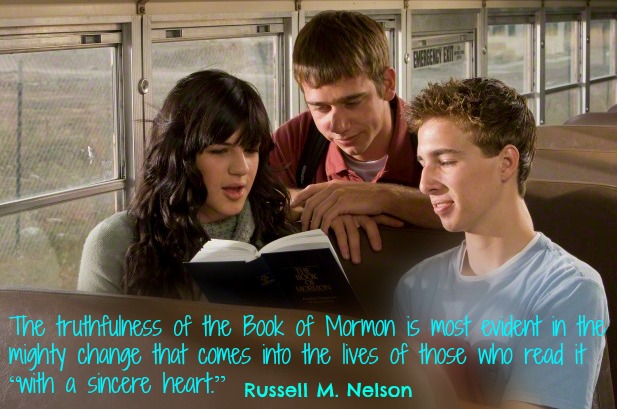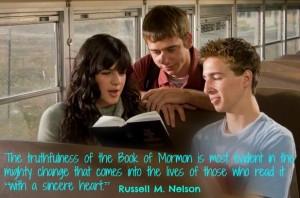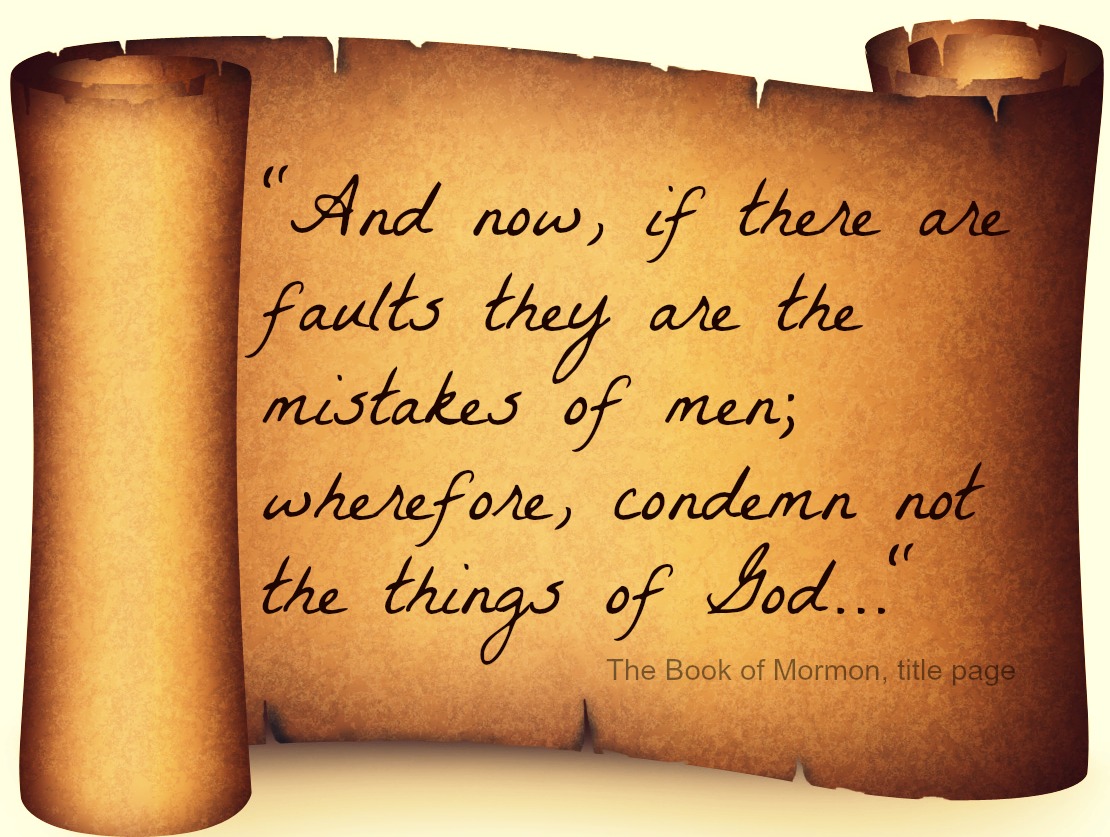As a mother, I use conditional sentences frequently. “If you don’t clean your room, then you will lose your favorite blanket (or toy or whatever).” “If you don’t brush your teeth, then you will get cavities.” But it never occurred to me that grammatical conditional sentence construction could be used to prove the authorship of the Book of Mormon, another testament of Jesus Christ and a companion scripture to the Bible. At Brigham Young University, the flagship school of The Church of Jesus Christ of Latter-day Saints (sometimes inadvertently called the Mormon Church because of members’ belief in the Book of Mormon), scholars of ancient texts are doing just that.
The Book of Mormon is a record of God’s dealings with the inhabitants of the ancient Americas, who sailed here from Biblical lands. BYU professor Daniel Peterson says that the discovery of the “if/and” sentence construction made by his colleague, professor Royal Skousen, in his textual study of the Book of Mormon proves this linguistic lineage. Peterson writes:
In grammar, “conditional sentences” are sentences that discuss hypothetical situations and their consequences. Languages use a variety of constructions and verb forms to form such sentences…. A very common form of conditional sentence is the “if/then” construction, with the word “then” being optional…. What is absolutely not a common conditional form — in any period or dialect of English— is an “if/and” construction. Native speakers simply don’t use it. We never say things like, … “If you cook it, and I’ll eat it.” Yet, although it never survives into English Bible translations, this construction is common in biblical Hebrew.
That is why it is significant to find “if/and” conditionals in the earliest English Book of Mormon, which presents itself as the translation of a record written by ancient Hebrews and their descendants. [1]
Skousen’s work has produced an in-depth linguistic analysis of the Book of Mormon and—for members of The Church of Jesus Christ— further proof of the authenticity of the book.
A Study of Book of Mormon Texts
The Book of Mormon came forth under miraculous circumstances—and has been a topic of scholarly debate ever since. Joseph Smith, the first prophet of The Church of Jesus Christ of Latter-day Saints, (the restoration of Christ’s ancient church) was led to the gold plates by a heavenly messenger named Moroni. It’s important to note that Joseph Smith had very little formal education and, at the time of the translation, “could neither write nor dictate a coherent and well-worded letter, let alone dictat[e] a book like the Book of Mormon,” according to his wife, Emma. [“Last Testimony of Sister Emma,” Saints’ Herald 26 (Oct. 1, 1879), 290.] Almost all of the present-day text of the Book of Mormon was translated during a three-month period between April and June of 1829, with a schoolteacher named Oliver Cowdery working as Joseph Smith’s scribe. The manuscript dictated by Joseph to his scribes is called the Original Manuscript, and only 28% of this document survives today. To assist in the printing of the book, Oliver Cowdery made a handwritten copy of the manuscript, which is known today as the Printer’s Manuscript. [2]
In the nearly 200 years since the first printing of the Book of Mormon, there have been 20 published editions of the book— 15 published by The Church of Jesus Christ, 4 by the Reformed Church of Jesus Christ of Latter-day Saints (now the Community of Christ, which is a separate church established by former members years after the death of Joseph Smith) and one private edition published in 1858 by James Wright in New York City. Skousen has spent a quarter of a century studying each of these editions as well as the Original and Printer’s manuscripts to discover, as nearly as possible, the earliest text of the English translation of the Book of Mormon. [3]
Skousen’s findings are fascinating—but don’t detract from the truthfulness of the doctrine or the book. He writes:
… It has been a delight to have discovered evidence in the original manuscript to support what witnesses said about how Joseph Smith translated. In my initial work on the original manuscript of the Book of Mormon, I was always excited to discover the occasional error that had crept into the text. But over time I have become more amazed about the nature of the original text of the Book of Mormon. In particular, the original manuscript provides important evidence that the Book of Mormon is a revealed text from the Lord. Indeed, the consistency of the original language supports the argument that the text was revealed to the Prophet Joseph Smith, word for word. [4]
The Significance of ‘If/And’
The Book of Mormon was written by ancient prophets whose ancestors came to the Americas from Jerusalem and other Biblical lands in a language called “reformed Egyptian.” (See Mormon 9:42 and 1 Nephi 1:12.) The significance of the Hebraic “if/and” construction is that it supports the linguistic heritage of the original authors of the Book of Mormon. As a young man with limited formal education, Joseph Smith would have no knowledge of this grammatical sentence structure. Peterson writes:
Joseph Smith would not have seen the Hebrew “if/and” conditional sentence in the King James Bible. Yet, in the original dictation manuscript of the Book of Mormon, 1 Nephi 17:50 reads “if he should command me that I should say unto this water be thou earth and it shall be earth.” That “and” was removed when Oliver Cowdery produced the so-called “Printer’s Manuscript,” but similar constructions— too many to dismiss as coincidental— appeared in the 1830 first edition. [1]
Skousen points out an entire sequence of “if/and” sentences in Helaman 12:13-21. For example, in verse 13: “yea and if he sayeth unto the earth move and it is moved.” Skousen writes:
Beginning with the 1837 edition, all these examples of the extra and have been edited out of the text. Such examples of a Hebraistic if-and construction in the original text provide further evidence that Joseph Smith received the text word for word. If he had received only ideas, there would have been no reason to have added the non-English use of and in all these examples. [4]
Peterson writes:
Such expressions— poor English, but good Hebrew— were eliminated by Joseph Smith himself in the second printing of the Book of Mormon. Though an unlettered man, he was a native speaker of English; he knew that these constructions were “wrong.” What we see in them, I think, is “language contamination,” leakage from the text’s original language into the translation language — much the way Spanish/English interpreters sometimes slip into “Spanglish.” But why would such things appear in “the most correct book?” Perhaps as a subtle divine hint that the original language of the Book of Mormon wasn’t English. [1]
Scholarly Studies vs. A Testimony of the Book of Mormon
Skousen’s study of the Book of Mormon provides an in-depth look into the textual changes of these scriptures. Richard Turley, assistant church historian and recorder for The Church of Jesus Christ, called Skousen’s work “the finest understanding that we have all had about the Book of Mormon.” [5] His work provides a rich background story through the textual changes that we can get in no other way. As Turley says, Skousen’s analysis is “an evaluation on how (Joseph Smith) translated it and what kind of text was revealed to him.” [5] The Critical Text Project is interesting, but is not the source upon which a testimony of the Book of Mormon is built—in other words, how a person knows that this book is the word of God. In the Introduction, the Prophet Joseph Smith writes:
I told the brethren that the Book of Mormon was the most correct of any book on earth, and the keystone of our religion, and a man would get nearer to God by abiding by its precepts, than by any other book.
But this analysis of the Book of Mormon isn’t necessarily designed to help others gain a testimony of the book. Even Skousen wrote:
There has also been a spiritual dimension to this work, although my own testimony of the Book of Mormon is not based on my work on the critical text project, but rather on my own personal witness that this book records events which really happened. [4]
Rather, the analysis is a fascinating study of the Book of Mormon text and how it has changed—and hasn’t really changed at all—from the first translation to the latest published edition of the scripture. Skousen wrote:
The systematic nature of the original text and the spelling out of Book of Mormon names support the theory that the text was revealed to Joseph Smith, word for word and even letter for letter. On the other hand, all subsequent transmissions of the text appear to be subject to human error. At each stage, the accuracy of the transmission has depended upon the carefulness of the transmitter, whether Joseph Smith, his scribes, or later editors and typesetters. (This caveat, of course, equally applies to the critical text itself.) Although all have tried to do their best, every transmission of the text appears to have led to some mistakes. Yet none of these errors significantly interfere with either the message of the book or its doctrine. These textual errors have never prevented readers of the book from receiving their own personal witness of its truth.
The editing of the text (including Joseph Smith’s for the 1837 edition) should, in nearly all instances, be viewed as translating the text into a more standard variety of English. Moreover, in his editing of the text, Joseph acted as a human editor; his 1837 and 1840 revisions do not represent any kind of “final authorial intent” since Joseph Smith is not the author of the Book of Mormon. Nor is there any evidence that his editorial revisions represent inspired corrections to the text, especially since he left unchanged dozens of substantive errors that the scribes originally made when they copied from the original manuscript to the printer’s manuscript.
The original text of the Book of Mormon reflects the style of Early Modern English—namely, the biblical style from the 1500s. Nonetheless, this biblical style in the Book of Mormon is not identical to the style of the King James Bible except in those Book of Mormon passages which directly quote from the King James Bible (such as Isaiah and Matthew). [4]
These findings, as Skousen has pointed out, in no way detract from the truthfulness of the Book of Mormon. Rather, they illustrate the truthfulness of the words of an ancient prophet, found on the Title Page of the Book of Mormon:
And now, if there are faults they are the mistakes of men; wherefore, condemn not the things of God, that ye may be found spotless at the judgment-seat of Christ.
How Can We Know the Book of Mormon is The Word of God?
How, then, can we find out for ourselves whether the Book of Mormon is the word of God? The Introduction to the Book of Mormon tells us:
We invite all men everywhere to read the Book of Mormon, to ponder in their hearts the message it contains, and then to ask God, the Eternal Father, in the name of Christ if the book is true. Those who pursue this course and ask in faith will gain a testimony of its truth and divinity by the power of the Holy Ghost. (See Moroni 10:3–5.)
Those who gain this divine witness from the Holy Spirit will also come to know by the same power that Jesus Christ is the Savior of the world, that Joseph Smith is His revelator and prophet in these last days, and that The Church of Jesus Christ of Latter-day Saints is the Lord’s kingdom once again established on the earth, preparatory to the Second Coming of the Messiah.
This is how Skousen gained his testimony of the Book of Mormon. He writes:
About twenty-five years ago, as I was reading the Book of Mormon during a time of personal difficulty, I reread the account of Ammon, King Lamoni, and the queen in Alma 19, which records the moment when the servant woman Abish raises the queen from the ground (Alma 19:29–30):
“And it came to pass that she went and took the queen by the hand, that perhaps she might raise her from the ground; and as soon as she touched her hand she arose and stood upon her feet, and cried with a loud voice, saying: O blessed Jesus, who has saved me from an awful hell! O blessed God, have mercy on this people!
“And when she had said this, she clasped her hands, being filled with joy, speaking many words which were not understood….”
As I was reading this passage, the spirit personally witnessed to me, “This really happened.” I have always cherished this moment in my life, and have been grateful to the Lord for the sure knowledge that the Book of Mormon is the word of the Lord. [4]
I love this because it illustrates how each person can gain a testimony of the truthfulness of the Book of Mormon—by reading, then praying and asking God, and finally receiving an answer through the Holy Ghost. Elder Russell M. Nelson, a member of the Quorum of the Twelve Apostles (with the First Presidency, the governing body of The Church of Jesus Christ), taught:
I would like to add my testimony of the divinity of this book. I have read it many times. I have also read much that has been written about it. Some authors have focused upon its stories, its people, or its vignettes of history. Others have been intrigued by its language structure or its records of weapons, geography, animal life, techniques of building, or systems of weights and measures.
Interesting as these matters may be, study of the Book of Mormon is most rewarding when one focuses on its primary purpose—to testify of Jesus Christ. By comparison, all other issues are incidental.
When you read the Book of Mormon, concentrate on the principal figure in the book—from its first chapter to the last—the Lord Jesus Christ, Son of the Living God. …
Each individual who prayerfully studies the Book of Mormon can also receive a testimony of its divinity. In addition, this book can help with personal problems in a very real way. Do you want to get rid of a bad habit? Do you want to improve relationships in your family? Do you want to increase your spiritual capacity? Read the Book of Mormon! It will bring you closer to the Lord and His loving power. [6]
The Book of Mormon is the word of God, and we can know this for ourselves. The Hebraisms and other discoveries that Professor Skousen found in his Critical Text Project add another rich layer to what many already know: that this book is true, and it was written by ancient prophets who sailed to the Americas from Jerusalem.




Recent Comments